* you might want to get a cuppa… it’s a long one *
Hmmm. I don’t really know where to begin.
It feels like an unfeasible task to put into words the physical, mental and emotional challenge that was Mind 3000s. However, having just completed an unfeasible task, I know I can do it. I guess it’s best to start at beginning, and with the facts.
Arriving
The Lovely Joe gallantly drove me the 300 miles from Somerset to Keswick on Friday 15th May. Long car journeys are made so much easier by the lack of small children. We both have sufficiently well trained bladders and attention spans to push on through without having to stop at every other service station; we stopped once and only once. We could listen to whatever music we wanted – even though our boy has good taste having been strongly coerced by Joe, he does get rather stuck on albums, and listening to Odgens Nut Gone Flake or The White Album on repeat for 6 hours can be a bit tiresome. We didn’t need to take out a loan to fund the mountain of juice cartons and snacks necessary to prevent the perceived starvation and dehydrated which occurs in a child’s mind if they go more than 30 minutes in a vehicle without sustenance. And finally, most triumphantly, no one was car sick. A very successful journey.
We arrived at the hostel and I nervously looked around for familiar faces from Facebook, of people who I had ‘met’ but never met. I eventually found Caroline in my dormitory, a lady who had been active on the Facebook Mind 3000s page and who, in that way only social media can foster, I felt I already knew. We stumbled across Matt and Charlie and all apprehensively giggled, talked about our journeys, the weather forecast and how nervous we were, before deciding we’d better go to the pub to meet more of our fellow trekkers who were having a pre-trek pint. Within half a pint we were all feeling more relaxed and I drank 2 pints of Thatchers, which wasn’t really part of my pre-trek plan but certainly helped with the ‘forming’ part of team building.
At 6ish we headed back to meet more trekkers, eat some carbs and have a safety briefing with our guide team. It was exciting meeting everyone but I was glad to have Joe there – it’s exactly that sort of large social gathering with people I don’t know that my anxiety dictates I try to avoid like the plague. The guides talked through how the following day would pan out and gave us the joyous news that our wake up call would be 4am. After we’d eaten, some trekkers went back to the pub (much to the dismay of the leader of the guide team) but I knew it was time for me to go to bed. Joe, very selflessly, went along as my representative for a couple of snifters.
4am came round quickly but the adrenaline kicked in as soon as I woke up and feeling tired wasn’t something I was aware of. I faffed about with what to wear, what to carry, what the weather was going to do, would I be too hot?… too cold?… etc. My mind felt a whirl. Having prepared, listed, shopped, packed, unpacked and re-packed for the past 2 weeks, I ended up leaving the hostel not knowing if I was equipped or not.
Scafell Pike
We began trekking at 5.45am in the rain. The first mile or so was flat and gave a good chance for the muscles to warm up. For 2 hours we trekked, in a long crocodile, up the craggy, boulderous terrain of Scafell Pike. As I often find with exercise, the first 30 minutes felt a struggle until my body warmed up and got into a rhythm. The climb was a challenge and involved scrambling and sharp ascents, but the Lucozade was doing the trick and I had the energy to do it comfortably. The group carried on ‘forming’, chatting generally whilst individuals also sought out particular bonds. I chatted to a few people in more depth about their reasons for doing the trek – their own mental health, the mental health of loved ones. All very diverse and different reasons, each of them touching, most of them hopeful, some desperately sad.
The final climb to the summit of Scafell Pike was tricky and involved a lot of concentration from my clumsy self. It really was hand over foot climbing at points and, as I looked down into a chasm; a sharp, rocky descent followed by a steep ascent built of boulders to the peak, I thought to myself that we couldn’t possibly be taking that route. When I realised that we were taking that route, I just carried on. There wasn’t a great deal of time for self doubt and, to be honest, our leaders were so confident and enigmatic that I probably would have tried to fly off the mountain if they had assured me that I could. I really had totally faith in them. They were magnificent.
We summited at 9am. It was freezing cold, very windy and the cloud was low over the peak so we had no views. It was disorientating; although we were told we were at the highest point in England and my knees were certainly telling me that this was true, I had no sense of how high up we were or the scale of the landscape below us. It was a bit like being in a small whitewashed room with no windows and some rocks in the middle. It felt quite unreal that we were up a mountain, but again, I trusted our guides that we were.
Scafell
The trek from Scafell Pike to Scafell was undoubtedly the most challenging part of the whole experience for me. Our guides told us that, of every 100 people who climb Scafell Pike, only 1 person goes on to climb Scafell. I can see why this is. There are only two routes – one is pretty much a sheer rock face which I would imagine has to be climbed with safety equipment, while the other option is just as preposterous…
After descending more terrain which consisted of large boulders we came to a steep valley where the ground changed and became more like large craggy steps with a load of scree added on top. Some of this descent for me was a case of sitting on my bottom and lowering myself down, as my knees aren’t the strongest. When we came to the bottom we were faced with a waterfall, which we were told we were going to climb. (I’m actually laughing rather hysterically while I recall and write this.)
Again, full trust was placed in the guides and as a wiggly stripe, we began climbing the waterfall. At the beginning it was fairly wide and the crags we had to negotiate were not too deep. We were climbing hand over foot and pulling ourselves up from ledge to ledge. As we got higher, the waterfall became narrower, the stones became more slippery, the ledges became smaller and the steps became deeper. For the beginning part I had someone in front of me and I was basically copying their movements, but I could feel the panic rising and my breath becoming shallower. I couldn’t keep up the pace and I lost my guide. At this point I stopped being able to see where to put my hands and my feet and felt full panic descending on me. It is a horrible realisation that you are heading into a panic attack, because this only makes you panic more.
I found a ledge large enough to sit on, where I struggled for breath and cried. Suddenly I felt engulfed– the months of training, the trek, grief, anxiety, depression. I wasn’t scared of falling. As is often the case with panic attacks, the specific reason for it was unclear. I just know I felt I was being crushed and I couldn’t get my lungs to inflate or my brain to focus. I hadn’t had a panic attack for over 6 months and I couldn’t help but begin to analyse what this meant and whether it was the start of a downward spiral.
Thankfully I was surrounded by patient, understanding, calm trekkers – Steph, Vicky and Charlie – and Matthew, the guide who was at the back of the group, who was honest with me about the fact I needed to keep going, but also reassuring. After a few minutes I had calmed enough to carry on. What was my option? There’s a problem with resigning when you’re one and a half mountains up. Quitting can only really happen at the bottom of the mountain. If I didn’t carry on upwards then I still had to climb down the waterfall, and then trek for 4 hours before I could ‘quit’. There was no way I wasn’t making the summit. Someone climbed in front of me, I followed their lead and made it to the top of the waterfall. Here I couldn’t stop the tears as I started thinking about Ian, but I knew that if I went down that road then there was a danger that I would end up as a little puddle of tears on the rocks. I had to make a decision, and it was to be – literally – onwards and upwards. Onwards and upwards, that is, towards the scree slope to end all scree slopes.
We summited at 11am, 5 hours after we first began walking.
The scramble back down inevitably involved my nemesis, but strangely going down the waterfall was not as overwhelming as going up. Matthew had taken it upon himself to look out for me and literally instructed me where to place my hands and feet. From the bottom of the waterfall we re-traced our steps all the way back up and down the mountains, via Scafell Pike (seeing as we summited Scafell Pike twice, surely this counts as 5 mountains?). The climb down was long and laborious but at 4.15pm, I reached the wonderful vision, the mirage, the holy grail of mountain climbers – a loo and a support vehicle.
We whizzed back to the hostel for some soup, a change of socks and an unpack / repack of backpacks, before setting off for Hellvelyn.
The Waterfall
Hellvelyn
The beginning part of climbing Hellvelyn involved me faffing about to put waterproofs on as the rain began, then 10 minutes later stopping to take them off as the sun came out. I realised I had forgotten two of the most important items of kit – gloves and hat . It just goes to show that if you have too much nonsense in your bag, packed for every eventuality, you end up forgetting the important things. The sun was bobbing in and out of the clouds and we got some really beautiful views as we climbed higher. The first quarter of Hellvelyn was steep and involved some hand over foot climbing, but it wasn’t too challenging. Some trekkers were height phobic and I was amazed at their determination and bravery in getting through some very tricky moments with steep drops immediately to our left.
As we reached the top of the first section, the ground became grassy and springy underfoot which was nothing short of a joyous change from rocks and boulders. I never thought I would be in a situation where grass made me so happy. For me, the ascent from here until I reached the summit was the high point of the whole challenge. One more long, steep section took us to the flat part of Hellvelyn which leads eventually to the summit, where legend has it, it’s so flat that it’s possible to land a plane. The sun was setting and the views from this point were far reaching and stunning. I was trekking with Hannah, a fitness instructor. Every time I was struggling or slowing she would say to me “come on girl, we got this”. If ever I am doubting myself in future I will think of her saying this to me. As it turned out, she was right.
We summited at 9pm. It was desperately cold and windy on the summit and I raced as fast as I could to get extra layers on. I used my scarf as a hat under the two hoods of my two jackets. It really was that cold. Someone very kind had lent me some fingerless gloves which I wore then stuffed my hands into my pockets as luckily it was possible to walk without needing my arms and hands to steady me at this stage.
The descent was very hard on my knees as the path was essentially a very large set of steep steps leading to the bottom of the mountain. By 9.45 the light was disappearing and I realised the total inefficiency of my head torch. I blogged about this previously and I should have listened to my gut instincts. It was useless unless I held it in my hand and pointed it at the floor, which defeats the point of it being a head torch and, even when used in this way, offered a pathetic amount of illumination. As the darkness fell I found myself walking alone, in between groups; at some points I couldn’t see another soul. Being a bit scared of the dark I tried not to think in too much depth about the fact that I was walking down a mountain, in the dark, alone. As I neared the bottom, I suddenly hoped I had been following the right path, and felt very relieved to see our guide leader waiting at the foot. He showed me to the support vehicle and promised me I could borrow a decent head torch for Skiddaw.
By 11pm we were back at the hostel eating chilli, taking on more water and layering up again, ready for tackling the fourth and final peak.
Skiddaw
The support vehicle took us to the foot of 3,054ft Skiddaw and we began climbing at midnight. Reading this back, it seems a totally bizarre, ridiculous and foolish thing to do. There is truth in the cliché that half the battle in an endurance challenge like this one, both in training and in the event itself, is mental. I put in as many training hours as I could to get as fit as I could, and I did some lengthy walks to prove to myself that I could keep going and going. I’d had limited opportunities to do significant hill training, and no opportunities to do any mountain training. But the seed was sowed in my mind, and I had the conviction. If I had started the day believing I was going to climb one mountain, I would have done that and then refused to believe I could have done anymore. However, starting the day in full acceptance that I was going to climb four mountains meant that I had wholehearted belief and faith that that was what I would do, as long as injury or illness did not stop me. It is a very specific state of mind. I have always hated the phrase ‘if you put your mind to it you can do anything’ because I don’t think it’s true, but in this case it has some relevance.
Having been told by many people that Skiddaw would be the easiest and most straightforward of the four mountains, I was dismayed at how tough I found it. With the benefit of hindsight and perspective, this was of course because we were in our 18th hour of mountain walking. We were all feeling the burn and were very tired. The ascent is steep but the terrain is easy. Even so, I found that I was having to stop and take a short rest every ten minutes or so. Unlike on previous mountains, we made more of an attempt to stick together as a group due to the darkness and the very real possibility of losing someone.
I walked the mountain mainly with Caroline and Hannah. I don’t really recall talking very much – just occasionally grunting at one another, swearing and half-heartedly telling each other that we could do it. By this point there were 14 of us left from the original group of 22. People had had to drop out, much to their dismay, at various points throughout the day, due to injury, fatigue or blisters. I felt grateful that I’d managed not to injure myself and it felt a feat to be on the last leg (excuse the pun). My memories from Skiddaw are sketchy and, it sounds obvious, but just consist of walking, trudging, and stumbling, teeth gritted and digging very deep, in the darkness. Walking when you have no visual point of reference is a strange experience. There is no sense of distance, or progression. We had no idea how close, or otherwise, we were to the summit or the car park, of how far we had come or of how far we had left to go. It was like being in a bad dream where you are walking and walking but not getting anywhere.
At around 2.30am the wind began to pick up and become very cold. Joe had courageously climbed Skiddaw earlier that day, to recky it out for me, and had said it was windy at the top. I hadn’t quite understood exactly how windy he had meant – Joe is the king of understatement. It turns out ‘pretty windy’ means ‘blowing a bloody gale’. As we climbed higher the wind got stronger and stronger until it was very difficult to walk in. The cloud had descended as we neared the summit and visibility was poor at about 3 metres. It was incredibly disorientating so we just stuck together and I made sure I could always see someone, as the wind also made it impossible to hear each other. Suddenly I was terribly glad that I had bought a whistle at the last minute. Whether I would have been able to find it in my bag was a different matter, but it was a comfort to know it was there, just in case I needed it. By the time we reached the summit I had been lifted off my feet by 90mph winds and dropped onto my bottom. We were instructed by our trek leader to ‘hit the floor’, which we all did to wait until the gust had dropped slightly. It was really frightening, but we reached the summit at 3am. I have no idea what the summit looks like, but I know I was there. We had one photo taken then began the descent. Once we had dropped out of the wind again, the final climb down just seemed to go on and on. Caroline and I did the descent together, and I think we had some quite diverse and bizarre conversations at 4am, having been walking for 22 hours. I felt delirious, my eyes were doing funny, spotty, stripey tricks and I was hallucinating gates and grassy paths. The sky was getting light as the sun was rising behind the clouds and finally, at around 4.15am, the gate, car park and support vehicle appeared.
We had done it. We had finished.
Reflections
This week, since the trek, has been a strange mix of elation, disbelief, pride, sadness, deflation and comedown.
The trek has really meant more to me than I ever realised it possibly would, and has helped me in fundamental ways which I didn’t appreciate that it possibly could. I can’t sum up fully my thoughts and feelings about being involved in this event, and I feel grateful that I have blogged throughout the process of training, to record some of the things I have learnt, realised and understood in the process.
Firstly – cash. My donations stand at £3300, with more still to come in. The collective fundraising of the group is over £60,000. The reality of this legacy is that it will save lives. The money will be spent on Mind’s phone lines. Currently they cannot answer all the calls they receive due to a 50% increase in calls in the last year. In crisis, an answer on the end of the phone may be the difference between someone receiving help and moving forwards or remain stuck, struggling and stressed; between someone choosing life or conceding to death.
The trek and the media opportunities I have been given have enabled and encouraged me to be open about mental illness and have provoked discussions I would never have otherwise had. More than this, the trek has allowed me to be honest about and take ownership of who I am now, and of about my brother and his suicide. In some cases I’ve been able to defend and explain is actions. He deserves this. He was not selfish, or short-sighted or hasty. He did not want to die, he just couldn’t live anymore. He was desperately ill. I feel I have had the opportunity to advocate for him and in some small way, perhaps change a couple of people’s thoughts and assumptions about mental illness and suicide.
The people I met on the trek are courageous, determined and superhumanly strong both mentally and physically, in spite of and probably because of their various personal struggles and conflicts. They are a group truly worthy of aspiring to, and they inspire me immensely. I have made friends who I know I will stay in contact with and who I feel I can lean on, despite only meeting them for less than 48 hours.
A significant aspect of my grief and depression has been a loss of faith in people and in human nature, which I have found shattering and devastating. The fundraising aspect of the trek, and the way that friends, family and strangers have supported me has overhauled and reconstructed this loss into faith and trust again. It is a different, more cautious belief, but it is there again. I have not ‘moved on’, but I have undoubtedly changed direction. It is a life changing liberation for me to have hope once again.
My Mum and Dad wrote me a card to be opened on the Sunday after I had completed the trek. My Dad wrote, ‘Walk on, with hope in your heart, and you’ll never walk alone’. Now I have hope. Now I will not walk alone.
Thank you, Mind.
Until another place and another time, thank you for reading my thoughts.
Louise x
Above are photos of all four summits in order – Scafell Pike, Scafell, Hellvelyn and Skiddaw – and me, at 4.30am, having finished the trek

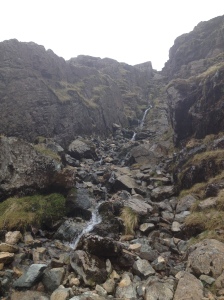
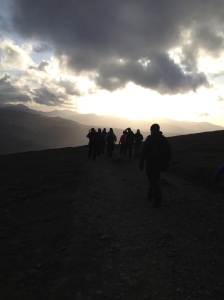
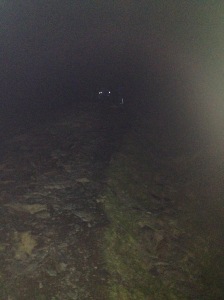

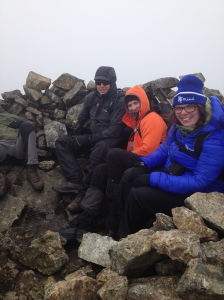

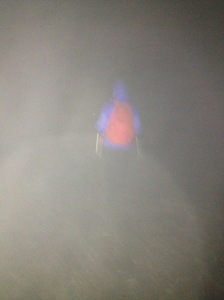

Reblogged this on Psychology Ponderings.
LikeLike
This is a lot more than just an account of your trek. it is a great read and there are a lot of analogies with the challenges we face and overcome in life itself. The whole of the song, which comes from the musical ‘Carousel,’ is worth a read, starting with the bit which goes, ‘when you walk through a storm, hold your head up high.’ it’s funny how words set to music are able to tug the heart-strings, both to help us express sorrow and to inspire us to keep going against all odds. Apart from being a good read, I love the way you have drawn the parallels with what life has been like for the whole family over the three plus years since Ian died. I am also thinking of ‘sail on silver girl’ from ‘Bridge over Troubled Water, the cd you gave me – that is also inspirational in life’s battles. I truly loved doing some of the training walks with you – you know how inspirational I find walking and landscapes, so keep hold of the ‘hope’ and don’t let it go. Then, for sure, you will never walk alone. God bless, courageous and beautiful daughter! Sounds soppy, but really isn’t. Honest.
LikeLike
Thanks Dad. The whole process has been an amazing experience for so many reasons. I have really enjoyed walking with you, we must keep it up (perhaps not quite so intensively!). Thanks for all your help and support xx
LikeLike
Well done Louise, I haven’t seen you this week to hear all about it so feel a bit better now I’ve read that. I was thinking of you all day when you were trekking. You’ve done so well, looking forward to celebrating your incredible accomplishment (that’s not the right word is it?! But I can’t think of the right one) later! Xxxx
LikeLike
Thanks babe. It certainly was a good celebration the other night, I only just feel human again! Lots of love xx
LikeLike
1. Well done! Awesome, awesome achievement!
2. OMG I can’t believe they made you go BACK over Scafell Pike!!!! I think you are quite justified in considering that to be a 5 peak walk, not 4.
3. In my experience Skiddaw is the one to do in the dark, it is by far the least exciting one.
4. If you ever feel like some company doing them again, but one at a time… 😉
Nancy x
LikeLike
Thank you Nancy! (I think it was definitely 5 too!) Louise x
LikeLike
I’ve delayed replying as there is so much I want to say, but I guess I’ll have to be selective. Well, you did it, just as we all knew you would. We are immensely proud of you and your achievement. Over the past 2 or 3 weeks, one word has been recurring to me and that is ‘enormity’. This blog has really brought home to me the enormity of what you have done. When you started out on this great challenge I don’t think that I took in fully what you had committed yourself to. Your training walks with dad left me with the pleasure of childminding and to me it was just fun! But you have proved that, whilst there was a ‘fun’ element to it all there was also the serious business of training and raising money. And reading this blog reminded me again of the enormity of events for us all over the last 3+ years and in total the last 12+years, since Ian first became ill. You have been so focused in bringing this to the fore and honouring Ian’s memory. I will really miss reading your weekly blogs – the ups and downs of the whole process have gripped me. And we mustn’t forget The Lovely Joe who has supported you every step of the way. So, although the words seem inadequate, VERY, VERY WELL DONE. All my love, Mum xxxx
LikeLike
Thank you Mum for all your support and for your treats! It has indeed been enormous. XXX
LikeLike